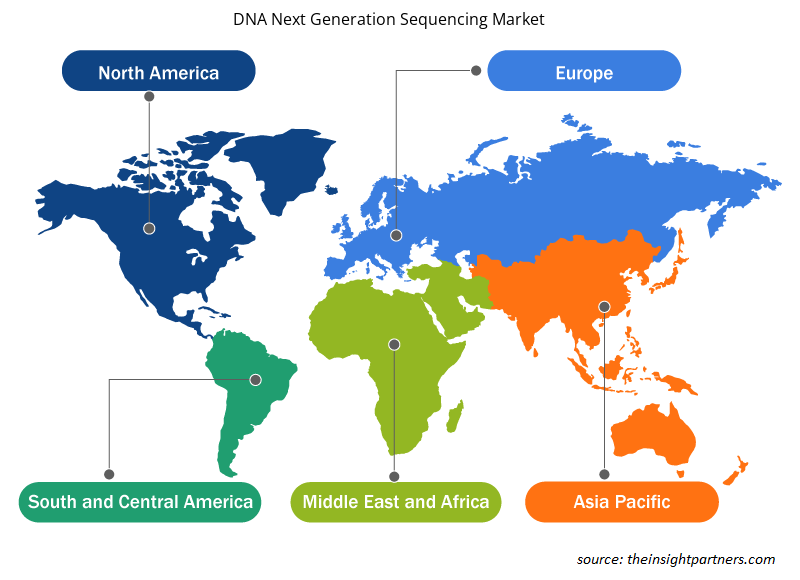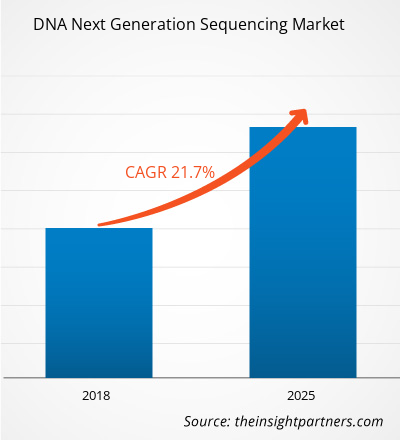[研究报告] DNA下一代测序市场规模预计将从2017年的48.985亿美元增至2025年的227.169亿美元;预计2018-2025年期间的复合年增长率为21.7%。
下一代测序也称为高通量测序。NGS能够对 DNA 样本中的碱基对进行快速测序。NGS正在推动药物发现应用,并实现个性化医疗、遗传疾病和临床诊断的未来。此外,下一代测序 ( NGS ) 是一种大规模并行测序技术,可以确定整个基因组中核苷酸的顺序,具有可扩展性、超高通量和快速性。由于它包括为后续测序反应准备样本,因此 DNA预测序是整个测序协议中最重要的过程之一。在全球医疗保健领域,NGS正稳步融入临床实验室分析、测试和疾病诊断中。在药物基因组学中,NGS已被广泛用于加快药物发现过程。
DNA下一代测序市场的增长归因于全球癌症病例的增加、研究的增加、研究机构和市场参与者之间的合作增加以及 DNA 下一代测序的应用增加和测序技术的技术进步。然而,熟练专业人员的缺乏预计将严重影响整个 DNA 下一代测序市场的增长。
定制此报告以满足您的需求
您可以免费定制任何报告,包括本报告的部分内容、国家级分析、Excel 数据包,以及为初创企业和大学提供优惠和折扣
- 获取此报告的关键市场趋势。这个免费样品将包括数据分析,从市场趋势到估计和预测。
市场洞察
测序价格下降和测序方法技术进步推动 DNA 下一代测序市场
近年来,下一代测序价格大幅下降。2000 年,人类基因组测序成本为 37 亿美元,耗时 13 年。然而,近年来,该成本在 2006 年降至 1000 万美元,并在 2012 年进一步下降,且该过程所需的时间更少。Illumina 和 Roche 等主要的 DNA 下一代测序市场参与者已推出突破性技术,这些技术具有成本效益,测序过程所需的时间更短。
此外,分子生物学领域的进步也同样增强了测序程序。过去几年,许多行业参与者都推出了创新的NGS技术。例如,Pacific Biosciences推出了 Sequel,Oxford Nanopore推出了PromethION。此外,占据市场主导地位的三种先进NSG系统包括 Roche GS FLX (454)、Illumina HiSeq 2000 ( Solexa ) 和 AB SOLiD ( Agencourt )。
进一步修改和自动化该过程继续增加测序数据,也使时间管理更加高效,从而使研究人员能够实现人类基因组计划的重大里程碑。NGS使基于序列的基因表达分析成为模拟技术的“数字”替代方案。基因组测序的进步使测序变得简单而准确。这些技术进步很可能在不久的将来推动 DNA 下一代测序市场规模。
基于产品的见解
全球 DNA 下一代测序市场根据产品细分为平台、服务和耗材。平台部分进一步细分为 HiSeq 系列、MiSeq 系列、SOLiD、Ion Torrent、Pacbio Rs II 和 Sequel Systems 等。此外,服务部分细分为测序服务和数据管理和分析服务。此外,耗材部分细分为样品耗材制备和其他 NGS 耗材。2017 年,耗材部分在 DNA 下一代测序市场的产品细分中占有较大份额,预计在预测期内也将呈现类似趋势。较新的 NGS 平台采用了一种称为单分子测序 (SMS) 的新测序方法,该方法不需要事先扩增 DNA,从而避免了与 PCR 相关的错误读取或对重复区域的扩增偏差。在过去五年中,下一代测序 (NGS) 已从研究过渡到临床使用。至少有 14 个国家制定了对大规模人口进行测序的计划,预计到 2025 年全球将有超过 6000 万人进行基因组测序。
基于应用的洞察
根据应用,全球 DNA 下一代测序市场细分为诊断、药物发现、精准医疗和其他应用。诊断领域在 2017 年占据最大份额,预计未来五到六年将出现显着增长。下一代测序 (NGS) 技术在诊断基因组护理中的使用需要精确度和准确性。NGS 技术使用具有成本效益的测序从全基因组测序中获取有关患者的基因组信息以执行临床操作。下一代测序最终将取代传统技术来诊断各种遗传疾病。现在可以通过一次测试解决大量基因,而不必采用逐个基因的方法。
基于最终用户的洞察
根据最终用户,全球市场分为学术和研究机构、制药和生物技术公司、医院和诊所以及其他最终用户。学术和研究机构部分预计将在预测期内实现最高增长。序列有助于科学家找到特定 DNA 片段所携带的遗传信息类型。例如,科学家可以使用序列信息来确定哪些 DNA 片段包含基因,哪些片段携带调控指令,从而打开或关闭基因。马里兰州罗克维尔的基因组研究所 (TIGR) 引入了基于随机或散弹枪测序的自动化工业化方法,并发表了 337 个新的人类基因和 48 个来自其他生物的同源基因
DNA 下一代测序市场区域洞察
Insight Partners 的分析师已详尽解释了预测期内影响 DNA 下一代测序市场的区域趋势和因素。本节还讨论了 DNA 下一代测序市场在北美、欧洲、亚太地区、中东和非洲以及南美和中美洲的细分市场和地理位置。

- 获取 DNA 下一代测序市场的区域特定数据
DNA 下一代测序市场报告范围
| 报告属性 | 细节 |
|---|---|
| 2017年市场规模 | 49亿美元 |
| 2025 年市场规模 | 227.2亿美元 |
| 全球复合年增长率(2017 - 2025) | 21.7% |
| 史料 | 2015-2016 |
| 预测期 | 2018-2025 |
| 涵盖的领域 | 按产品
|
| 覆盖地区和国家 | 北美
|
| 市场领导者和主要公司简介 |
|
市场参与者密度:了解其对商业动态的影响
DNA 下一代测序市场正在快速增长,这得益于终端用户需求的不断增长,这些需求源于消费者偏好的不断变化、技术进步以及对产品优势的认识不断提高等因素。随着需求的增加,企业正在扩大其产品范围,进行创新以满足消费者的需求,并利用新兴趋势,从而进一步推动市场增长。
市场参与者密度是指在特定市场或行业内运营的企业或公司的分布情况。它表明在给定市场空间中,相对于其规模或总市场价值,有多少竞争对手(市场参与者)存在。
在 DNA 下一代测序市场运营的主要公司有:
- Illumina 公司
- 赛默飞世尔
- 凯杰公司
- 北京基因组研究所
- 珀金埃尔默公司
免责声明:上面列出的公司没有按照任何特定顺序排列。

- 获取 DNA 下一代测序市场顶级关键参与者概览
产品发布和批准是公司扩大其全球影响力和产品组合的常用策略。此外,市场参与者专注于合作战略以扩大客户群,这反过来又使他们能够在全球范围内保持自己的品牌名称。随着市场参与者开发新的创新产品,市场份额预计将蓬勃发展。相关市场的一些市场参与者包括赛默飞世尔科技公司;Illumina,Inc;Qiagen NV;北京基因组研究所;PerkinElmer,Inc.;F.Hoffman-La Roche Ltd.;安捷伦科技;Eurofins Scientific;Oxford Nanopore Technologies Ltd;和 Macrogen Inc。
- 历史分析(2 年)、基准年、预测(7 年)及复合年增长率
- PEST 和 SWOT 分析
- 市场规模价值/数量 - 全球、区域、国家
- 行业和竞争格局
- Excel 数据集



Report Coverage
Revenue forecast, Company Analysis, Industry landscape, Growth factors, and Trends

Segment Covered
This text is related
to segments covered.

Regional Scope
North America, Europe, Asia Pacific, Middle East & Africa, South & Central America

Country Scope
This text is related
to country scope.
常见问题
The DNA next generation sequencing market is growing at CAGR of 21.7% from 2018-2025.
Major market players such as Illumina and Roche have introduced breakthrough technologies that have enabled in the cost and time reduction in the sequencing.
As per forecast report, the market value of DNA next generation sequencing market in 2025 will be US$ 22,716.9 Million.
The growth of the global DNA next generation sequencing market is attributed to the increases in cancer prevalence, technological development and decreasing price of sequencing. Owing to factors like advances within the field of genetic science, development in several ways and methods for sequencing, there's a notable decline within the price of sequencing.
Trends and growth analysis reports related to Life Sciences : READ MORE..
The List of Companies
1. Illumina, Inc.
2. Thermo Fisher
3. Qiagen N.V.
4. Beijing Genomics Institute
5. PerkinElmer, Inc.
6. Hoffman-La Roche Ltd.
7. Agilent Technologies
8. Eurofins Scientific
9. Oxford Nanopore Technologies Ltd.
10. Macrogen Inc.
The Insight Partners performs research in 4 major stages: Data Collection & Secondary Research, Primary Research, Data Analysis and Data Triangulation & Final Review.
- Data Collection and Secondary Research:
As a market research and consulting firm operating from a decade, we have published and advised several client across the globe. First step for any study will start with an assessment of currently available data and insights from existing reports. Further, historical and current market information is collected from Investor Presentations, Annual Reports, SEC Filings, etc., and other information related to company’s performance and market positioning are gathered from Paid Databases (Factiva, Hoovers, and Reuters) and various other publications available in public domain.
Several associations trade associates, technical forums, institutes, societies and organization are accessed to gain technical as well as market related insights through their publications such as research papers, blogs and press releases related to the studies are referred to get cues about the market. Further, white papers, journals, magazines, and other news articles published in last 3 years are scrutinized and analyzed to understand the current market trends.
- Primary Research:
The primarily interview analysis comprise of data obtained from industry participants interview and answers to survey questions gathered by in-house primary team.
For primary research, interviews are conducted with industry experts/CEOs/Marketing Managers/VPs/Subject Matter Experts from both demand and supply side to get a 360-degree view of the market. The primary team conducts several interviews based on the complexity of the markets to understand the various market trends and dynamics which makes research more credible and precise.
A typical research interview fulfils the following functions:
- Provides first-hand information on the market size, market trends, growth trends, competitive landscape, and outlook
- Validates and strengthens in-house secondary research findings
- Develops the analysis team’s expertise and market understanding
Primary research involves email interactions and telephone interviews for each market, category, segment, and sub-segment across geographies. The participants who typically take part in such a process include, but are not limited to:
- Industry participants: VPs, business development managers, market intelligence managers and national sales managers
- Outside experts: Valuation experts, research analysts and key opinion leaders specializing in the electronics and semiconductor industry.
Below is the breakup of our primary respondents by company, designation, and region:

Once we receive the confirmation from primary research sources or primary respondents, we finalize the base year market estimation and forecast the data as per the macroeconomic and microeconomic factors assessed during data collection.
- Data Analysis:
Once data is validated through both secondary as well as primary respondents, we finalize the market estimations by hypothesis formulation and factor analysis at regional and country level.
- Macro-Economic Factor Analysis:
We analyse macroeconomic indicators such the gross domestic product (GDP), increase in the demand for goods and services across industries, technological advancement, regional economic growth, governmental policies, the influence of COVID-19, PEST analysis, and other aspects. This analysis aids in setting benchmarks for various nations/regions and approximating market splits. Additionally, the general trend of the aforementioned components aid in determining the market's development possibilities.
- Country Level Data:
Various factors that are especially aligned to the country are taken into account to determine the market size for a certain area and country, including the presence of vendors, such as headquarters and offices, the country's GDP, demand patterns, and industry growth. To comprehend the market dynamics for the nation, a number of growth variables, inhibitors, application areas, and current market trends are researched. The aforementioned elements aid in determining the country's overall market's growth potential.
- Company Profile:
The “Table of Contents” is formulated by listing and analyzing more than 25 - 30 companies operating in the market ecosystem across geographies. However, we profile only 10 companies as a standard practice in our syndicate reports. These 10 companies comprise leading, emerging, and regional players. Nonetheless, our analysis is not restricted to the 10 listed companies, we also analyze other companies present in the market to develop a holistic view and understand the prevailing trends. The “Company Profiles” section in the report covers key facts, business description, products & services, financial information, SWOT analysis, and key developments. The financial information presented is extracted from the annual reports and official documents of the publicly listed companies. Upon collecting the information for the sections of respective companies, we verify them via various primary sources and then compile the data in respective company profiles. The company level information helps us in deriving the base number as well as in forecasting the market size.
- Developing Base Number:
Aggregation of sales statistics (2020-2022) and macro-economic factor, and other secondary and primary research insights are utilized to arrive at base number and related market shares for 2022. The data gaps are identified in this step and relevant market data is analyzed, collected from paid primary interviews or databases. On finalizing the base year market size, forecasts are developed on the basis of macro-economic, industry and market growth factors and company level analysis.
- Data Triangulation and Final Review:
The market findings and base year market size calculations are validated from supply as well as demand side. Demand side validations are based on macro-economic factor analysis and benchmarks for respective regions and countries. In case of supply side validations, revenues of major companies are estimated (in case not available) based on industry benchmark, approximate number of employees, product portfolio, and primary interviews revenues are gathered. Further revenue from target product/service segment is assessed to avoid overshooting of market statistics. In case of heavy deviations between supply and demand side values, all thes steps are repeated to achieve synchronization.
We follow an iterative model, wherein we share our research findings with Subject Matter Experts (SME’s) and Key Opinion Leaders (KOLs) until consensus view of the market is not formulated – this model negates any drastic deviation in the opinions of experts. Only validated and universally acceptable research findings are quoted in our reports.
We have important check points that we use to validate our research findings – which we call – data triangulation, where we validate the information, we generate from secondary sources with primary interviews and then we re-validate with our internal data bases and Subject matter experts. This comprehensive model enables us to deliver high quality, reliable data in shortest possible time.


 获取此报告的免费样本
获取此报告的免费样本